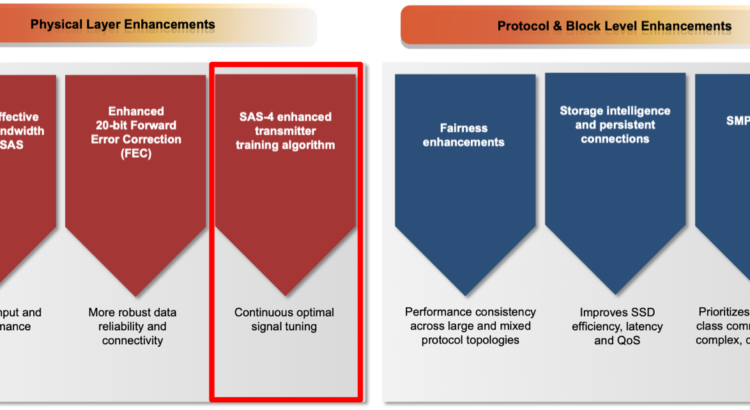[Editor’s Note: This is part of a series of upcoming blog posts discussing 24G SAS features.]
By: Rick Kutcipal (SCSI Trade Association), with contributions from Tim Symons (Microchip), November 12, 2019
The first 24G SAS plugfest was held the week of June 24, 2019, and products are expected to begin to trickle out into the marketplace in 2020. Production solutions typically follow 12-18 months after the first plugfest. These storage technologies are tied to OEM server and storage vendors, which release solutions at a regular annual cadence sometimes tied to next generation Intel or AMD processors. Servers almost always lead the way, as they push the performance envelope and keep pace with faster processors, faster networking and faster storage.
To address the growing performance requirements of modern data centers, 24G SAS doubles the effective bandwidth of the previous SAS generation, 12Gb/s SAS. To achieve this bandwidth, the physical layer experiences significant electrical demands that technologies such as forward error correction and Active PHY Transmitter Adjustment (APTA) specifically address. These enhancements are required to maintain the rigorous quality and reliability demands of IT professionals managing enterprise and data center operations.
To ensure optimized transceiver operation, APTA automatically adjusts the SAS PHY transmitter coefficients to compensate for changes that happen over time in environmental conditions. This compensation is accomplished continuously with no performance implications.
In the SAS-4 standard, APTA defines specific binary primitives that the receiver PHY and the transmitter PHY exchange. These primitives request changes to the transmitter PHY coefficient settings and report transmitter status without requiring that the PHY terminate connections and enter a PHY reset sequence, ensuring continuous operation.
To ensure that no disruption to data transfer occurs and to allow the SAS PHY receiver to adapt to changes in the transmitter PHY settings, the time between each APTA change request is at least 1ms. Making small, single-step changes allows the SAS PHY receiver to adjust to the change over a long period of active data bits. Small changes give the SAS PHY receiver time to equalize before the SAS PHY receiver algorithm calculates the next change request, if any changes are forthcoming.
Small changes over a long time period ensures that the channel does not diverge from an operational range that could cause a link reset sequence. The SAS link is not disrupted by the APTA process and all connections, as well as data transfers, continue uninterrupted, yet optimized, by APTA. APTA states cannot be processed when the PHY is in the SP15: SAS_Phy_Ready state.
The APTA process might take several seconds to complete; however, making small adjustments avoids SAS connection disruption and enables a PHY transmitter and PHY receiver to return to optimal signal integrity conditions for reliable data transfer./
While performance requirements continually increase within the modern IT infrastructure, the quality and reliability metrics remain unchanged. Technologies such as APTA enable 24G SAS to meet these requirements, and ensures the most reliable and robust storage connectivity.
Look for future installments of 24G SAS Feature Focus, as the SCSI Trade Association takes a closer look at key enhancements that make your storage faster and more reliable.

24G SAS Enhancements: Active PHY Transmitter Adjustment (APTA)
